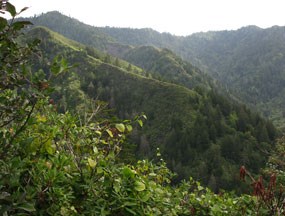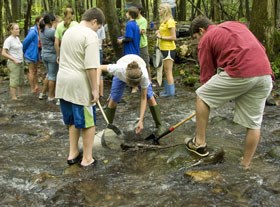
NPS photo by Laura Carnal. There are seven programs in Resource Management and Science: Air Quality, Cultural Resources, Fire, Fisheries, Inventory and Monitoring, Vegetation, and Wildlife. Meet the people and projects in Inventory & Monitoring. What is Inventory & Monitoring (I & M)? Scientists in the park’s Inventory & Monitoring program have two important roles:
The Smokies covers over 500,000 acres, so scientists choose small areas called plots that represent the huge range of habitats and elevations in the park. Plots are in forests, grasslands, wetlands, and even sections of streams and cliff faces. Park geographers, biologists, botanists, foresters, and entomologists all take part in this work. Depending on what they’re studying, park staff may record
This information serves as a quantitative baseline. Over time, scientists return to the carefully mapped plots to watch for changes from this known baseline, which might be the first sign of a problem in the park ecosystem as a whole. 
NPS photo. Why inventory and monitor park life? The Smoky Mountains are one of the most species-rich parks in the national park system, and are designated as an International Biosphere Reserve and a World Heritage Site. On the ground, this means the park is home to species that are endangered, rare, and endemic (living only in the Smokies), as well as unique communities of plants and animals. We are not only mandated as a national park to protect these rare living resources, but also to preserve all of the native life within the park. To protect these resources, it is crucial to know what, where, and how species exist, and, over time, how they are changing. By looking at these documented trends that come out of inventory and monitoring work, scientists can then ask where, why, and how changes happen, and help park scientists, maintenance workers, and managers better protect the park's unique species and ecosystems. Many protected areas around the country have or are starting inventory & monitoring programs. The Great Smoky Mountains Inventory and Monitoring program is special because it was one of the first in the country. Now in its third decade, the program includes not only vascular plants and vertebrates, as many programs do, but also has inventory data on almost every physical and biological resource in the park. Scientists use that data to advise collaborator research, identify and protect rare or vulnerable species, and study ecological relationships between species and patterns across the park. The health of the resources is also vital to good management. Refocusing for the future 
Photo copyright Kevin FitzPatrick. Here are two ways to see some of the Inventory and Monitoring work in the field without even getting wet: 1. Go into the field with park scientists as they inventory park wetlands. 2. The park’s I & M program also works with a partner non-profit group, Discover Life in America (DLIA), to coordinate the All Taxa Biodiversity Inventory (ATBI). Study water mites in an Smokies stream or lichens on the rocks with ATBI researchers.Or, return to Nature main page. |
Last updated: March 15, 2021
